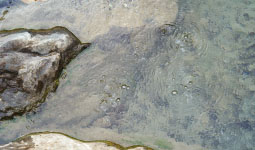Home > Highlighting JAPAN > Highlighting Japan March 2019 > From Hot Springs to Art: Japan’s Bath Culture
Highlighting JAPAN


Digging Your Own Outdoor Riverside Hot Spring
There are thousands of hot springs all throughout Japan. Kiriake Onsen in Nagano Prefecture is particularly noteworthy and fun because you can dig your very own onsen bath right by the river.
Akiyamago in Sakae Village is hidden away in a mountainous area on the northernmost tip of Nagano Prefecture. Suzuki Bokushi, a writer and merchant during the Edo Period (1603-1867), made detailed notes about the unusual practices and culture in the area in his Akiyama Travel Notes.
There are six onsen (hot springs) in the area. One is Kiriake, situated in the remotest part of Akiyamago where the Zako and Uono rivers meet, known as one of the country’s most unusual hot springs because you have to dig your own bath. (Many of the inns and other accommodations in the area rent shovels to guests.) The hot spring looks like a normal river at first glance, but the waters are steamy—roughly 54 degrees Celsius. You build your own bath while cooling the water to the desired temperature with the icy river water.
Looking closely at the river, you’ll see spots surrounded by rocks or deeper areas where you can immerse your whole body. Most likely prior visitors made these baths. If you step into those areas, you may be surprised at the sudden heat. Visitors walking around the river discover that parts of the river have significant differences in temperature. It’s best to find a spot that is relatively warm and dilute it to your preferred temperature, but then digging and customizing the bathing space is part of the fun of this hot spring. Since this is a free-running river there is no fee involved, but remember that there are also no changing rooms.
“There is no one managing the area, but the village office, tourist association and hotel staff help out by laying down wood chips to make an easier path to the river,” states Akihiro Shirahama of the Sakae Village Akiyamago Tourism Association. It’s advisable to contact the tourist association beforehand to check river conditions. From April to May, the river floods due to snow melt, so it isn’t possible to bathe until the end of May.
Bathing at Kiriake is also impossible on rainy days and when Shibusawa Dam conducts scheduled water releases. During the summer many families come to play in the river, and bathing while enjoying the green leaves or snow is also lovely. The most popular season is the fall foliage season, though, when you can soak while viewing the beautiful red and yellow leaves—a perfect way to enjoy autumn in Japan.
“There aren’t many hot springs where you get to build your own bath, and sometimes even spot wild monkeys or raccoons,” says Shirahama. “From the top of the bridge that crosses the Zako and Uono rivers there is also a great view of twin waterfalls. Getting there can be difficult, but buses are available if you make a request in advance. It’s a singular experience that is worth the trip.”
Not far from Kiriake Onsen you can see the magnificent Nunoiwayama cliffs, formed by magma between seven hundred and eight hundred thousand years ago. When approaching the mountain, keep an ear out for the loud roar from the winds that almost sound like a waterfall.
The wonderful natural scenery and unique bathing experience make Akiyamago a must-visit for adventurous travelers and onsen fans.
© 2009 Cabinet Office, Government of Japan








